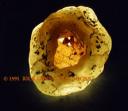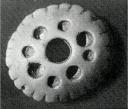A Seer, Or a Stone
From the reaction to The Mormons, it seems that a significant portion of the members of the LDS church had never heard of Joseph Smith’s seer stone or that it had been used in translation. The seer stones aren’t discussed often in the Mormon church or presented in reenactments of the translation of the Book of Mormon, but their use in early church history is an open secret. There have been many accounts of the seer stones from official church sources:
- A Treasured Testament by Elder Russell M. Nelson
- By the Gift and Power of God by Elder Neal A. Maxwell
- A Peaceful Heart
A search for “seer stone” in the Gospel Library at lds.org turned up these articles and many others. Russell M. Nelson quoted David Whitmer about the seer stone:
Joseph Smith would put the seer stone into a hat, and put his face in the hat, drawing it closely around his face to exclude the light; and in the darkness the spiritual light would shine. A piece of something resembling parchment would appear, and on that appeared the writing. One character at a time would appear, and under it was the interpretation in English. Brother Joseph would read off the English to Oliver Cowdery, who was his principal scribe, and when it was written down and repeated to Brother Joseph to see if it was correct, then it would disappear, and another character with the interpretation would appear. Thus the Book of Mormon was translated by the gift and power of God, and not by any power of man.
Photos of two of the seer stones alleged to be owned by Joseph Smith are readily available though I suspect that many Mormons have never seen them:
Another stone—the “brown” stone supposed to be the one Joseph Smith used to translate—is currently held in the vaults of the Mormon church in Salt Lake City.
I suspect that the seer stones aren’t often mentioned in LDS conversation because they make Joseph Smith seem peculiar (in a bad way) and reinforce the fact that Joseph was heavily involved in folk magic practices. This conflicts with the modern LDS distaste for such things and with their more romanticized notions of Joseph Smith.
Tags: cognitive dissonance, confirmation bias, folk magic, history, Joseph Smith, LDS, Mormonism, religion, seer stone, superstition

